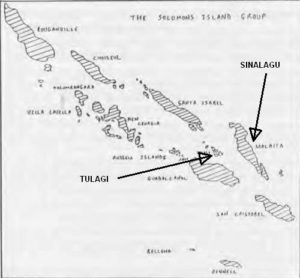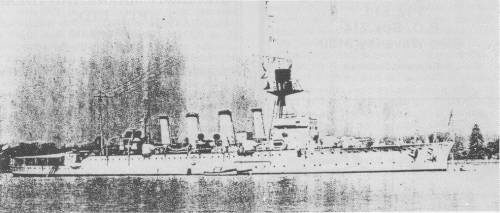- Author
- Swinden, Greg
- Subjects
- History - Between the wars
- Tags
-
- RAN Ships
- HMAS Adelaide I, RAFA Biloela
- Publication
- June 1994 edition of the Naval Historical Review (all rights reserved)
In early October 1927 the Town Class cruiser HMAS ADELAIDE lay alongside Garden Island in Sydney, having just returned from a cruise to the Solomon Islands, when news was received that their had been a bloody native uprising on the island of Malaita in the Solomons group.

The events leading up to the “native uprising” stemmed mainly from the Malaita natives intense hatred of the newly introduced annual “head tax”. This required every able bodied man to pay five shillings a year to the government of the British Solomon Islands Protectorate (BSIP).
The tax was very much taxation without representation, as the natives received very little in services for their five shillings. The tax had been introduced in an attempt to force the natives onto the British plantations in the Solomons which were short of labour. It was only on the plantations that a native could hope to earn enough cash in order to pay the tax. The natives also resented the gradual inroads into their traditional way of life that were being made by the BSIP authorities, missionaries and traders.
On 3 October William Robert Bell, the District Officer for Malaita, Cadet (Patrol Officer) K.C. Lillies and about 15 native police arrived at Sinalagu (Diamond Harbour) to collect the annual head tax from the local natives. Bell had been District Officer since 1915 and knew Malaita and its people well. Lillies was an ex British Army officer who had been Bell’s assistant since late 1925.
The next day Bell and Lillies sat at a desk outside a newly constructed “tax hut” as the natives filed up to pay their taxes. For most of the morning all went well despite warnings Bell had received that the local natives intended to oppose him over the collection of taxes.
Suddenly one of Malaita’s prominent warriors, Bassiana, stood in front of the desk as if to pay his taxes. As Bell looked up from the desk Bassiana produced a hidden rifle and clubbed Bell to death. This was the signal for other natives to attack. Although only armed with spears and a few old rifles the natives quickly overwhelmed the native police, armed with .303 rifles, killing nine of them and putting the rest to flight.
Several of the attacking natives were also killed or wounded in the brief skirmish. Cadet Lillies opened fire with his pistol wounding two natives before he was shot in the chest and killed. Later one of Lillies’s hands was allegedly cut off and taken as a battle trophy.
Anchored in the harbour at Sinalagu was Bell’s motor boat AUKI and the schooner WHEATSHEAF, and it was to here that the native police who had survived the attack fled. Although some had been badly wounded they managed to swim out to these vessels and raise the alarm.
Those onboard the vessels were uncertain of the situation ashore, apart from the fact that Bell and Lillies had been killed, so decided to sail to Tulagi and inform the authorities there. Tulagi, the administrative centre for the Solomons, was reached 18 hours later.
The massacre caused an instant uproar at Tulagi as the local white population believed it was only the start of a full scale native uprising. There is no evidence to suggest this was more than an isolated case of violence, however, the Resident Commissioner immediately cabled the Colonial Office in London and requested a warship be sent to the Solomons. The Colonial Office passed the request to the Admiralty who in turn passed the request to the Australian Naval Board in Melbourne.
Eventually the Minister of Defence authorised the involvement of the Royal Australian Navy (RAN).

Two 6-inch guns are sited forward of the bridge, one on each beam; two searchlights amidships and abaft the fourth funnel; a wireless cabin is sited between the fore and second funnels and the control top and director tower are painted black.




